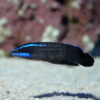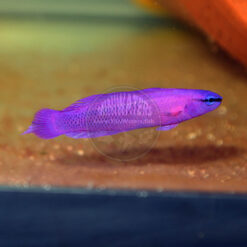Pseudochromis sankeyi “Striped Dottyback”, Captive Bred
Price range: $59.00 through $149.00
Dottybacks from the Red Sea, including the almost serpentine monochromatic Striped Dottyback, Pseudochromis sankeyi, have become staple offerings from ornamental marine fish breeders. Their widespread availability is bolstered by the fact that wild-caught versions of these species generally cost at least twice as much as the same species when captive-bred. Captive-bred dottybacks are incredibly resilient and hardy fishes.
Dottybacks’ reputation for aggression is, on the one hand deserved, but on the other hand, often blown out of proportion in my opinion. Sankeyi Dottybacks in particular have proven to be among some of the easiest going in captivity; in holding situations I’ve easily held a half dozen in tanks under 20 gallons with virtually no signs of aggression, and I’ve seen this repeated in the LFS environment as well.
Learn more about the Striped or Sankeyi Dottyback below:




















